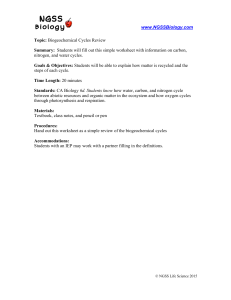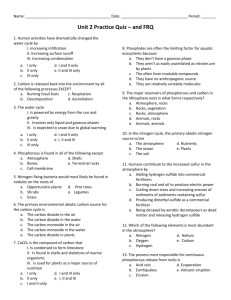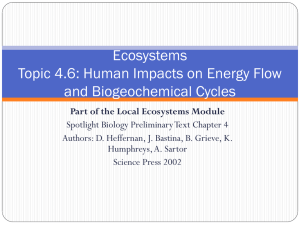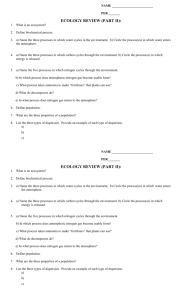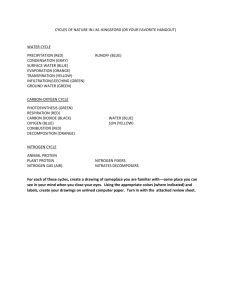Biogeochemical Cycles
advertisement
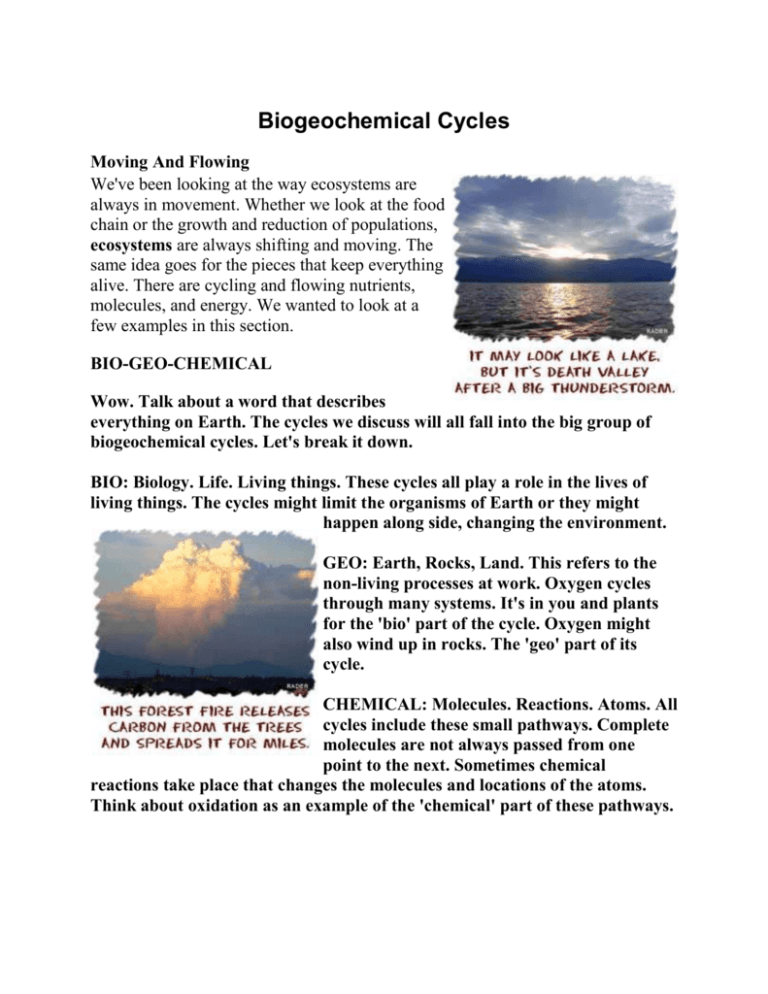
Biogeochemical Cycles Moving And Flowing We've been looking at the way ecosystems are always in movement. Whether we look at the food chain or the growth and reduction of populations, ecosystems are always shifting and moving. The same idea goes for the pieces that keep everything alive. There are cycling and flowing nutrients, molecules, and energy. We wanted to look at a few examples in this section. BIO-GEO-CHEMICAL Wow. Talk about a word that describes everything on Earth. The cycles we discuss will all fall into the big group of biogeochemical cycles. Let's break it down. BIO: Biology. Life. Living things. These cycles all play a role in the lives of living things. The cycles might limit the organisms of Earth or they might happen along side, changing the environment. GEO: Earth, Rocks, Land. This refers to the non-living processes at work. Oxygen cycles through many systems. It's in you and plants for the 'bio' part of the cycle. Oxygen might also wind up in rocks. The 'geo' part of its cycle. CHEMICAL: Molecules. Reactions. Atoms. All cycles include these small pathways. Complete molecules are not always passed from one point to the next. Sometimes chemical reactions take place that changes the molecules and locations of the atoms. Think about oxidation as an example of the 'chemical' part of these pathways. The Carbon Cycle All living things are made of carbon. Carbon is also a part of the ocean, air, and even rocks. Because the Earth is a dynamic place, carbon does not stay still. It is on the move! In the atmosphere, carbon is attached to some oxygen in a gas called carbon dioxide. Plants use carbon dioxide and sunlight to make their own food and grow. The carbon becomes part of the plant. Plants that die and are buried may turn into fossil fuels made of carbon like coal and oil over millions of years. When humans burn fossil fuels, most of the carbon quickly enters the atmosphere as carbon dioxide. Carbon dioxide is a greenhouse gas and traps heat in the atmosphere. Without it and other greenhouse gases, Earth would be a frozen world. But humans have burned so much fuel that there is about 30% more carbon dioxide in the air today than there was about 150 years ago, and Earth is becoming a warmer place. In fact, ice cores show us that there is now more carbon dioxide in the atmosphere than there has been in the last 420,000 years The Water Cycle Water plays many different roles on the Earth. Some is at the poles in ice caps, and some is in the snow and glaciers at the tops of high mountains. Some is in lakes and streams, and some is underground. Some is vapor in the atmosphere. But most of the water on Earth is in the oceans. Water is always on the move! The Sun’s energy causes water to evaporate from oceans and lakes into the atmosphere. Plants and animals also release water vapor into the atmosphere as they breathe. When the atmosphere cools, water vapor condenses; making clouds that might produce rain or snow. Water has been recycled in its different forms as ice, liquid, or vapor --for more than 3.5 billion years. The Nitrogen Cycle Take a deep breath. Most of what you just inhaled is nitrogen. In fact, 80% of the air in our atmosphere is made of nitrogen. Your body does not use the nitrogen that you inhale with each breath. But, like all living things, your body needs nitrogen. Your body gets the nitrogen it needs to grow from food. Most plants get the nitrogen they need from soil. Many farmers use fertilizers to add nitrogen to the soil to help plants grow larger and faster. Both nitrogen fertilizers and forest fires add huge amounts of nitrogen into the soil and nearby lakes and rivers. Water full of nitrogen causes plants and algae to grow very fast and then die all at once when there are too many for the environment to support.
